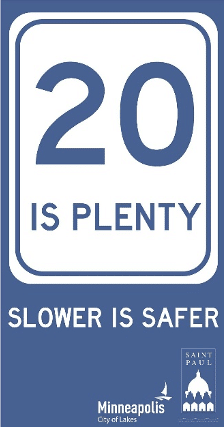Vision Zero is an international movement to create safer streets for everyone. Minneapolis joined this movement in September 2017, when it committed to a goal of zero traffic deaths and serious injuries by 2027.
Cyclists & Pedestrians Are Overrepresented in Crashes
According to city data, an average of 95 people are killed or severely injured in Minneapolis each year. Cyclists and pedestrians make up 45% of those severe injuries and deaths. These groups are overrepresented in these crashes, as they only make up 19% of total trips in Minneapolis. As a Minneapolis-based lawyer who handles cases of bike accidents and pedestrian injuries, I see this disproportion first hand. Vision Zero is mean to remedy it.
Most Crashes Occur on a Small Number of High-Injury Streets
A significant majority of fatal and severe crashes—70%—occur on approximately 9% of all city streets. Minneapolis has dubbed these “high injury streets.” My firm’s office is located on one of these streets: Lake Street. And we are just a few blocks down from one of the deadliest corridors in Minneapolis: Lyndale Avenue between Lake Street and Franklin Avenue.
The Lyndale Avenue corridor has been in the news a lot lately, and for good reason. Last October, a pedestrian was hit by a car while crossing Lyndale Avenue. He later died from his injuries. His death inspired numerous demonstrations and protests from individuals calling for the city to make its streets safer for all.
Vision Zero & Reducing Speeds to Increase Safety
Minneapolis is focusing on planned safety improvements on Lyndale and other high-injury streets over the next several years. A large focal point for the city is to cut back on the top five behaviors that lead to severe and fatal crashes identified in the 2018 Vision Zero Crash Study:
- Speeding
- Distracted driving
- Running a red light
- Unsafe turning
- Driving under the influence
Of these, speed is a significant factor. National data shows the risk of severe and fatal crashes drops drastically when lowering city street speeds down from 40 MPH and 30 MPH to 20 MPH.

This past March, the city of Minneapolis and its sister city, St. Paul, both committed to lowering speed limits on nearly all city-owned streets. According to the Vision Zero website, here is what the new speed limits will look like.
- 20 MPH for local residential streets
- 25 MPH for larger, arterial city streets
- 30 MPH+ for a few city-owned streets
County roads and MnDOT-controlled roads will not be affected by these city-based changes.

Two streets that will not see lower speed limits? Lyndale Avenue and Lake Street. Supporters of keeping these streets to 30 MPH say it is necessary due to the high volume of motorist traffic.
Protestors argue that one of the major factors in deaths and severe injuries along Lyndale is the speed itself. Refusing to lower the speed while installing smaller safety measures such as plastic posts isn’t going to make a marked improvement.
Still a Long Way to Get to Zero
I laud the city for its commitment to making our streets safer for cyclists, pedestrians and motorists. There is still so much to be done, however. I, for one, will keep an eye on legislative updates and infrastructure improvements while continuing to advocate for those who suffer from severe and fatal bike crashes.
Source for statistics and images (unless otherwise cited): Vision Zero Minneapolis website (last accessed 4/3/20)

Dan Brazil is a seasoned personal injury and Minneapolis bicycle crash attorney. Located in Uptown, Minneapolis, he serves bicyclists throughout Minnesota who has suffered injuries in bike crashes.
Dan is not only the founder and principal attorney of Brazil Law Group; he is also an avid biker. A self-proclaimed “all-arounder,” Dan commutes via bike (in nicer weather!), mountain bikes, runs trails, rock climbs, practices yoga, and even surfs.










